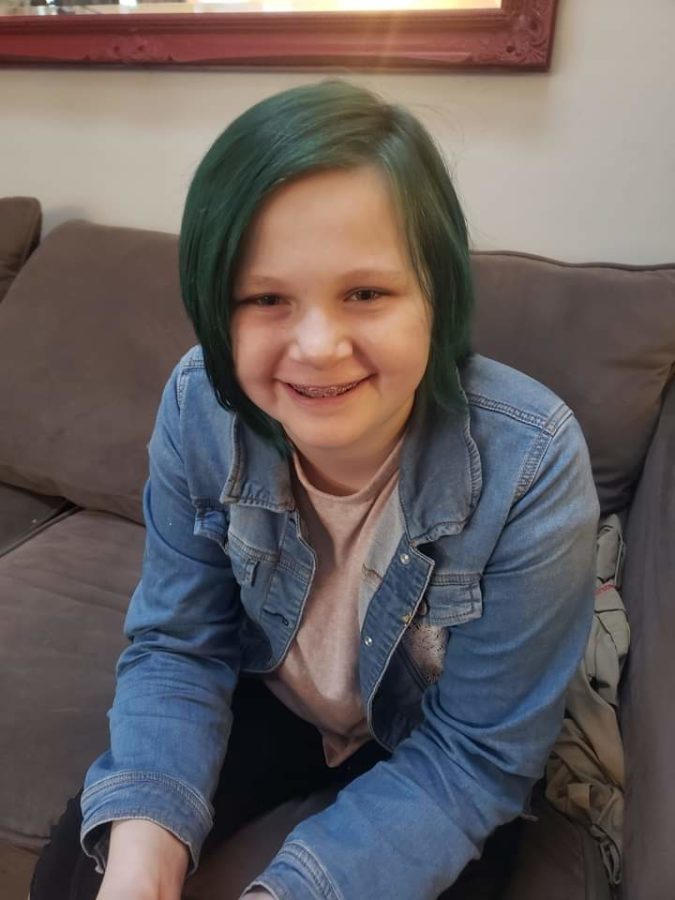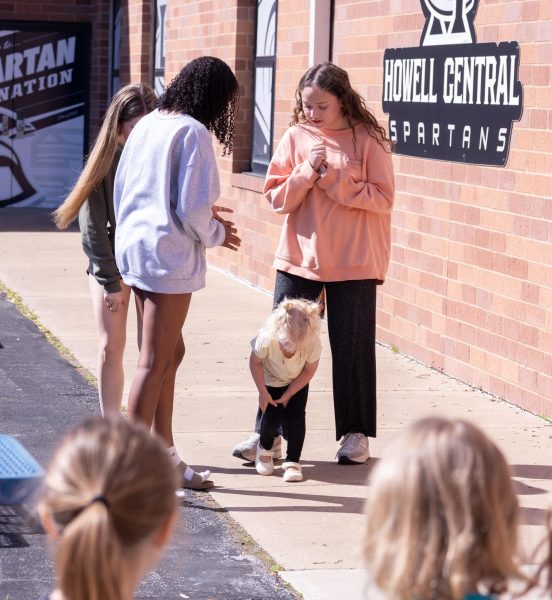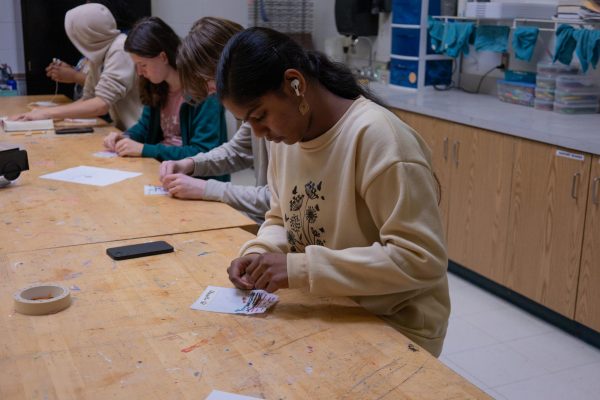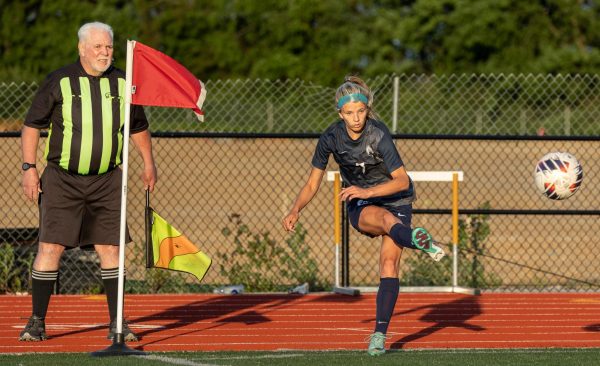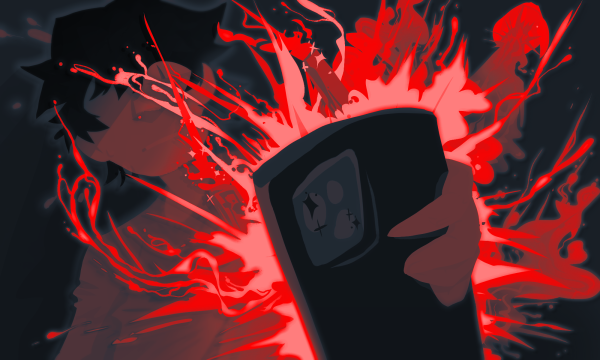Invisible Disabilities
The stigma surrounding illness you can’t see
HAIR DYE DISTRACTION: Rosemary Vrazel sits on her living room couch for a picture after dying her hair. She dyed it to bring something positive to a day with particularly bad flare-ups and pain.
Disability. When you read that word, you probably think of athletes in wheelchairs playing basketball, or children walking through halls with paras, or inspirational stories about a blind person navigating a visual world. What you are less likely to picture is an average looking fourteen-year-old girl riding her bike down a neighborhood street to visit her best friend after school. But that description is no less accurate in terms of what disability can look like because disability doesn’t always look the same – in fact, sometimes you can’t see it at all.
 My sister Rosemary is that little fourteen-year-old girl, living with a disability that people cannot see or even begin to comprehend. With a slew of four separate chronic illnesses – EDS, AMPS, MALS, and FND – and severe anxiety, depression, OCD, and mood disorders, each day for Rosemary is a struggle. One of these illnesses alone is enough to cause debilitating pain and significantly handicap a person, let alone several. Her joints are constantly popping out of place. She sprains and breaks bones easily because her body doesn’t produce collagen correctly to keep them together.
My sister Rosemary is that little fourteen-year-old girl, living with a disability that people cannot see or even begin to comprehend. With a slew of four separate chronic illnesses – EDS, AMPS, MALS, and FND – and severe anxiety, depression, OCD, and mood disorders, each day for Rosemary is a struggle. One of these illnesses alone is enough to cause debilitating pain and significantly handicap a person, let alone several. Her joints are constantly popping out of place. She sprains and breaks bones easily because her body doesn’t produce collagen correctly to keep them together.
She lives in constant stomach pain – but she’s so used to it, she’s tuned it out. She can have multiple panic attacks a day over things as simple and everyday as taking a shower. She can become overly emotional and worked up because of her inability to regulate emotions, sometimes having breakdowns similar to a four or five year old. And because of all the excess of anxiety and stress, her body converts that anxiety into episodes of partial paralysis with the inability to walk, or vocal and motor tics. Yet, as difficult as life is for her, people struggle to understand and comprehend simply because she does not “look” disabled.
This has been especially evident in Rosemary’s experience over the past nine months, as her illnesses have significantly worsened. She’s had close to 10 trips to the ER for various injuries and flare-ups, been hospitalized twice, and even switched schools to receive more support. With how serious things have become, my family has started the process of raising money to have a service dog trained for her. It’s my hope that, aside from providing much needed care and interventions, having a service dog will help others understand the severity of her condition. That it can somehow act as proof for those she encounters that her illness is indeed disabling.
All disabilities, visible and invisible, are challenging in their own ways and absolutely valid. But one problem unique to invisible disabilities is that people are much less compassionate and accommodating. If people saw a blind child walking down the street, they’d take care to get out of their way and be as helpful as they could – and anyone who didn’t would be seen as unkind. People would be quick to come to the child’s rescue.
With Rosemary, however, the situation could not be more different. Because she looks typical, her peers sometimes assume she’s faking her pain or trying to get out of work when she goes to the nurse at school. They shoot curious, judgmental glances our way when she starts to cry in public because she’s anxious and overwhelmed. And when all of her issues began to come to light and we struggled to find answers and a diagnosis, even doctors were suspicious of her pain, suggesting she was over dramatic and dismissing her situation without helping to find deeper answers. From the everyday judgment of peers to medical gaslighting, the struggle to be taken seriously is one she has faced for over eight years as her illnesses have worsened.
This stigma makes an already difficult situation even harder to bear. Going through excruciating pain daily, not being able to run and play like a normal kid because you’re always breaking bones, and having crippling panic attacks during the day is hard enough when you have the support you need. Exchange that support for contempt and suspicion, and the situation gets ten times harder – not only for the disabled person, but for their family and caregivers as well.

training, Amber. Photo (Courtesy of Caroline Vrazel)
With such a lack of compassion and understanding in the world, it’s been difficult for me to even know where to begin when talking about her issues. For years, it was something I never talked about – partially because it was just my family’s normal and seemed not worth mentioning. Besides that, her issues are so complex and involved it would take so long to explain. But it’s also because I didn’t know how people would react to her – would they be kind and understanding, or would they decide she’s just too much? Without the support of medical officials who were willing to diagnose her or trust her symptoms, it was at first hard for even me to recognize her illnesses and their effect on her life for what they truly are: a disability.
Thankfully, over the past several years as she’s finally gotten some diagnoses, it’s been easier to understand and also to cope with. Having the label of a disability has actually been freeing, because knowing what is causing her issues and having them validated has made it easier to discuss, which has been like a weight lifted off of my shoulders. It gives me the words to explain to my friends what’s happening when she has a panic attack, or why I missed rehearsal because of a family emergency when Rosemary was admitted to the hospital. It helps remove the stigma and shame surrounding invisible illnesses, removing the idea that those who suffer from them are simply crazy or broken. That validation is something needed – and also deserved – not only by athletes in wheelchairs and children with paras, but also by normal-looking fourteen-year-old girls who like to ride their bike to their best friend’s house after school.
Your donation will support the student journalists of Francis Howell Central High School. Your contribution will allow us to purchase equipment and cover our annual website hosting costs. FHCToday.com and our subsequent publications are dedicated to the students by the students. We hope you consider donating to allow us to continue our mission of a connected and well-informed student body.




